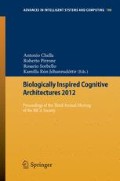Abstract
The authors are attempting to clarify the nature of human consciousness by creating functions similar to that phenomenon in a robot. First of all, they focused on self-aware, confirming a new hypothesis from an experiment on a robot using a neural network with the MoNAD structure which they created based on the concept of a human neural circuit. The basis of this hypothesis is that “the entity receives an anticipated response within a certain evaluation standard based on internal time.” This paper discusses the theory of awareness in robots, related experiments, this hypothesis and the prospects for the future.
Access this chapter
Tax calculation will be finalised at checkout
Purchases are for personal use only
Preview
Unable to display preview. Download preview PDF.
References
Gallese, V., Fadiga, L., Fogassi, L., Rizzolatti, R.: Action recognition in the premotor cortex. Brain 119, 3–368 (1996)
Donald, M.: Origins of the Modern Mind. Harvard University Press, Cambridge (1991)
Takeno, J., Inaba, K., Suzuki, T.: Experiments and examination of mirror image cognition using a small robot. In: The 6th IEEE International Symposium on Computational Intelligence in Robotics and Automation, CIRA 2005, Espoo Finland, June 27-30, pp. 493–498 (2005) IEEE Catalog: 05EX1153C, ISBN0-7803-9356-2
Takeno, J.: MoNAD structure and self-awareness. In: Biologically Inspired Cognitive Architectures (BICA 2011), Arlington, USA (2011)
Botvinick, M., Cohen, J.: Rubber hands “feel‟ touch that eyes see Nature, vol. 391(6669), pp. 756–756 (1998)
Fukuda, K., Shimada, S.: Effect of Delayed Visual Feedback on Rubber Hand Illusion (2009)
Mannor, J., Takeno, J.: Monad Structures in the Human Brain. In: CSIT 2011 (2011)
Author information
Authors and Affiliations
Corresponding author
Editor information
Editors and Affiliations
Rights and permissions
Copyright information
© 2013 Springer-Verlag Berlin Heidelberg
About this paper
Cite this paper
Takiguchi, T., Takeno, J. (2013). A Robot Uses an Evaluation Based on Internal Time to Become Self-aware and Discriminate Itself from Others. In: Chella, A., Pirrone, R., Sorbello, R., Jóhannsdóttir, K. (eds) Biologically Inspired Cognitive Architectures 2012. Advances in Intelligent Systems and Computing, vol 196. Springer, Berlin, Heidelberg. https://doi.org/10.1007/978-3-642-34274-5_53
Download citation
DOI: https://doi.org/10.1007/978-3-642-34274-5_53
Publisher Name: Springer, Berlin, Heidelberg
Print ISBN: 978-3-642-34273-8
Online ISBN: 978-3-642-34274-5
eBook Packages: EngineeringEngineering (R0)

